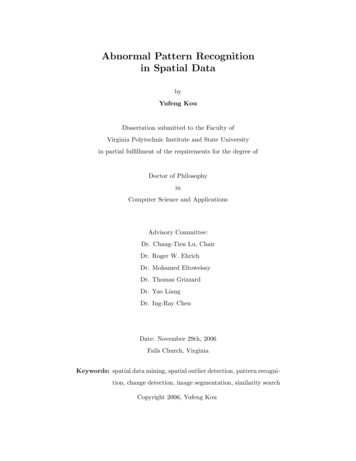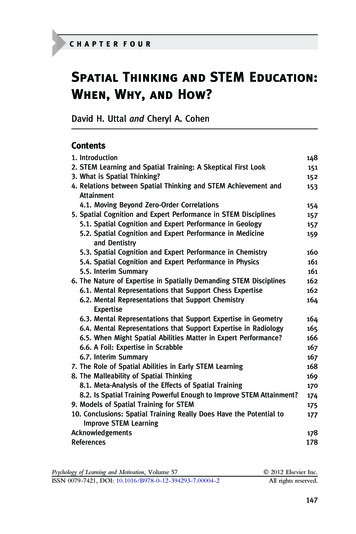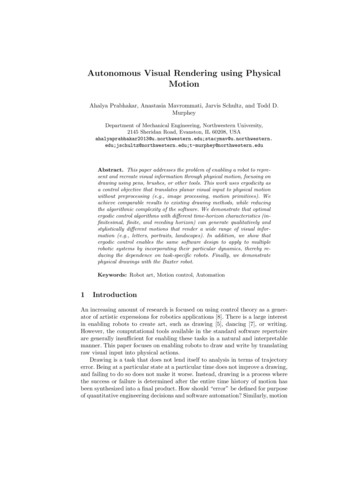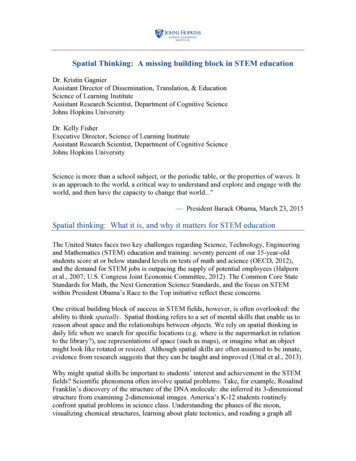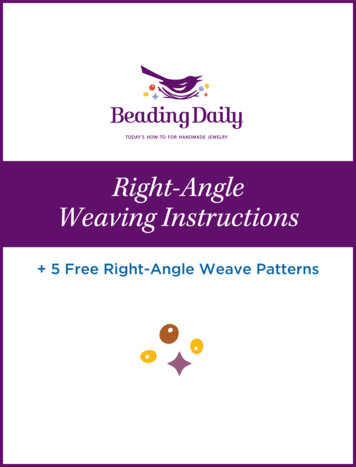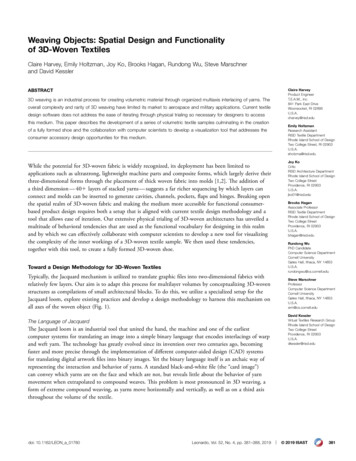
Transcription
Weaving Objects: Spatial Design and Functionalityof 3D-Woven TextilesClaire Harvey, Emily Holtzman, Joy Ko, Brooks Hagan, Rundong Wu, Steve Marschnerand David KesslerABSTRACT3D weaving is an industrial process for creating volumetric material through organized multiaxis interlacing of yarns. Theoverall complexity and rarity of 3D weaving have limited its market to aerospace and military applications. Current textiledesign software does not address the ease of iterating through physical trialing so necessary for designers to accessthis medium. This paper describes the development of a series of volumetric textile samples culminating in the creationof a fully formed shoe and the collaboration with computer scientists to develop a visualization tool that addresses theconsumer accessory design opportunities for this medium.While the potential for 3D-woven fabric is widely recognized, its deployment has been limited toapplications such as ultrastrong, lightweight machine parts and composite forms, which largely derive theirthree-dimensional forms through the placement of thick woven fabric into molds [1,2]. The addition ofa third dimension — 401 layers of stacked yarns — suggests a far richer sequencing by which layers canconnect and molds can be inserted to generate cavities, channels, pockets, flaps and hinges. Breaking openthe spatial realm of 3D-woven fabric and making the medium more accessible for functional consumerbased product design requires both a setup that is aligned with current textile design methodology and atool that allows ease of iteration. Our extensive physical trialing of 3D-woven architectures has unveiled amultitude of behavioral tendencies that are used as the functional vocabulary for designing in this realmand by which we can effectively collaborate with computer scientists to develop a new tool for visualizingthe complexity of the inner workings of a 3D-woven textile sample. We then used these tendencies,together with this tool, to create a fully formed 3D-woven shoe.Toward a Design Methodology for 3D-Woven TextilesTypically, the Jacquard mechanism is utilized to translate graphic files into two-dimensional fabrics withrelatively few layers. Our aim is to adapt this process for multilayer volumes by conceptualizing 3D-wovenstructures as compilations of small architectural blocks. To do this, we utilize a specialized setup for theJacquard loom, explore existing practices and develop a design methodology to harness this mechanism onall axes of the woven object (Fig. 1).The Language of JacquardThe Jacquard loom is an industrial tool that united the hand, the machine and one of the earliestcomputer systems for translating an image into a simple binary language that encodes interlacings of warpand weft yarn. The technology has greatly evolved since its invention over two centuries ago, becomingfaster and more precise through the implementation of different computer-aided design (CAD) systemsfor translating digital artwork files into binary images. Yet the binary language itself is an archaic way ofrepresenting the interaction and behavior of yarns. A standard black-and-white file (the “card image”)can convey which yarns are on the face and which are not, but reveals little about the behavior of yarnmovement when extrapolated to compound weaves. This problem is most pronounced in 3D weaving, aform of extreme compound weaving, as yarns move horizontally and vertically, as well as on a third axisthroughout the volume of the textile.doi: 10.1162/LEON a 01780Leonardo, Vol. 52, No. 4, pp. 381–388, 2019 ︲Claire HarveyProduct EngineerT.E.A.M., Inc.841 Park East DriveWoonsocket, RI 02895U.S.A.charvey@risd.eduEmily HoltzmanResearch AssistantRISD Textile DepartmentRhode Island School of DesignTwo College Street, RI 02903U.S.A.ehotzma@risd.eduJoy KoCriticRISD Architecture DepartmentRhode Island School of DesignTwo College StreetProvidence, RI 02903U.S.A.jko01@risd.eduBrooks HaganAssociate ProfessorRISD Textile DepartmentRhode Island School of DesignTwo College StreetProvidence, RI 02903U.S.A.bhagan@risd.eduRundong WuPhD CandidateComputer Science DepartmentCornell UniversityGates Hall, Ithaca, NY 14853U.S.A.rundongwu@cs.cornell.eduSteve MarschnerProfessorComputer Science DepartmentCornell UniversityGates Hall, Ithaca, NY 14853U.S.A.srm@cs.cornell.eduDavid KesslerVirtual Textiles Research GroupRhode Island School of DesignTwo College StreetProvidence, RI 02903U.S.A.dkessler@risd.edu 2019 ISAST381
Fig. 1. A 3D-woven shoe: woven in one form on an industrial Jacquard loom. ( VTRG 2019. Photo: Emily Holtzman.)3D Weaving Techniques and PracticesIn traditional 2D weaving, warp ends travel in the vertical direction and are usually assembled undertension on a beam, or large roll, while the weft yarns travel horizontally and are passed above and belowthe warp ends to create interlacings and woven patterns. 3D weaving utilizes these basic premises butwith some significant variations. First, 3D-weaving techniques enable multiple layers of fabric to bejoined together, sometimes linking layer to direct layer and sometimes running individual warp ends ina cascading motion throughout the fabric as “Z-tows” in a process called angle interlock (Fig. 2). Thismovement adds to the vertical warp action and horizontal weft action to create a third axis within thecloth. Second, the number of layers and the size of the materials significantly impact the duration ofweaving. Third, 3D weaving utilizes a creel for warping, which comprises an array of yarns that are placedindividually on a rack behind the loom. The creel allows each warp end to maintain tension, using asFig. 2. 3D-weaving architecture: the interlocking movement of warp ends through each layer of a 3D-woven fabric. (Imagescourtesy of T.E.A.M., Inc., Woonsocket, RI)382Harvey et al.︲Weaving Objects: Spatial Design and Functionality of 3D-Woven Textiles
Fig. 3. 3D-weaving loom and castout: industrial Jacquard loom for 3D weaving with creel and detail of harness.(Courtesy of T.E.A.M., Inc., Woonsocket, RI. Photo: Emily Holtzman.)much or as little of each warp as necessary throughout the fabric. The variable warp lengths combine withthe Jacquard mechanism to allow customizable architectures in the fabric [3].Many Jacquard-woven 3D fabrics are simple and take the form of rectangular billets molded into shapefor the composites industry [4,5,6]. A 3D-weaving setup requires a castout designed for depth anddensity rather than width, a key difference from more traditional decorative or greige woven goods. Thisdepth-prioritizing setup is essential for enabling the warp yarns to stack on top of rather than next to oneanother [7] (Fig. 3). Equally vital is the weft insertion sequence and mapping the shuttle path throughoutthe fabric. Given that most 3D-weaving setups incorporate a single shuttle, the same weft yarn must beprogrammed to pass entirely or partially across the fabricand to repeat actions in different sections of the fabric tobuild up necessary depth and material bulk.Computational ToolsCurrent CAD tools for 3D weaving provide littleinformation about yarn behavior within fabric. 3D fabricdesigners commonly work from sketched diagrams totranspose complex card images manually. We begin theprocess using Pointcarre, an industry standard textileCAD platform that maps weave structures to color poolsin a graphic image [8]. Pointcarre allows for dexterity intraditional fabric design, but is insufficient for 3D-weavedesign, failing to fully engage the complexity of layerswithin a 3D setup. Without spatial organization of3D-weave structures, it is common for fabrics designed inPointcarre to contain unnoticed errors. For more precisework, we require a binary tool in the form of a MicrosoftExcel sheet containing an array of hooks for distributingthe design pattern and shuttle path. As the graphic fileusually originates in Photoshop, current practice requiresthe use of a combination of Photoshop, Pointcarre andExcel to attain a working 3D-weaving file (Fig. 4).Fig. 4. Current design methodology: a. sketch of yarn paths in 3D file; b. sketchedshuttle pathways; c. file in Excel; d. Pointcarre assembly of Photoshop structures.( VTRG 2019)Weaving Objects: Spatial Design and Functionality of 3D-Woven Textiles ︲Harvey et al.383
Using this patchwork of programs, while ultimately effective, is tedious and error-prone. The few softwareplatforms that exist for visualization of 3D-weave structures such as Scotweave only permit constantweaving of the same architectural billets and do not support variations in the topography of the fabricor weave edge compatibility and shaping through controlled shuttle passage [9,10]. Pointcarre wasnot developed with the goal of creating 3D wovens and fails to address variations in depth or shuttlemovement, since the program simply tiles out the card image to be repeated in all areas of a color. Thisenables building catalogs of compatible weaves and populating a graphic image with structures, but giveslittle control over the actual movement of the yarn between the color pools or the attachment of discretelayers. While it is possible to craft a card image for these complicated design issues using current designtools, it remains difficult both to visualize and edit designs developed in this way (Fig. 5).A New ApproachPartnering with textile manufacturer T.E.A.M., Inc., we haveaccessed industrial weaving equipment to develop a rangeof samples exploring material and behavioral properties of3D-woven textiles. Through ongoing collaboration withcomputer scientists at Cornell and Stanford Universities,we have aided in the development of a software platformthat allows for the design of weave “blocks” that aggregateto complex 3D fabrics. The samples, together with the cardimages and the experiences gained from the productionprocess, have lent critical insight to the platform development.Each iteration of the platform in turn has further streamlinedan otherwise cumbersome workflow and enabled more trialing.To develop this new tool, we began a dialogue with thecomputer scientists about the challenges and inefficienciesof current platforms. For further reading, please see Irawan,Fig. 5. Building depth in Pointcarre: a. card image for the toe, ball and archKaldor, Leaf, Miguel et al. [11,12,13,14]. Traditional wovenof insole; b. use of supplementary wefts for depth in 2D Pointcarre file;design workflows do not address the specific problemsc. graphic file for building layers; d. woven sample with thick and thin areas.inherent to 3D-woven design, such as shuttle passageway, weft( VTRG 2018)sequencing or varying depths of pick columns. To efficientlydesign 3D-woven goods, a new design tool needed to combinethe precision of 3D-weave hand sketching with the ease of textile CAD interfaces. This tool would alloweasy programming in fabric cross sections that could join together and be viewed spatially. Customizationof weave blocks would allow the designer to articulate junctures and shuttle passage within the overallfabric. Upon design completion, an accurate card image would be automatically generated to drive theloom. The new tool that has emerged, Weavecraft, gives designers a way to visualize, collect and designweave structures as spatial architectures and provides a path for creating complex 3D-woven objects.The Project: A 3D-Woven ShoeGiven the specialized nature of 3D weaving as a way of creating volumes with woven fabric and itsunderutilized potential for complex object formation, we seek to demonstrate the capacity of the mediumby creating a technically sophisticated shape in the form of a 3D-woven shoe. We chose to create a shoe as agrand challenge to test our ability to understand the medium and to engage the dominant design object inthis domain, the Nike Flyknit sneaker, which has profoundly changed the market since release in 2012. Weask: Can an entire complex volume be produced through weaving rather than knitting or even 3D printing?A shoe is a functional object and an ideal vehicle for addressing many of the design issues emerging from3D weaving, such as varying density, layer linkages and shaping of distinct functional zones.384Harvey et al.︲Weaving Objects: Spatial Design and Functionality of 3D-Woven Textiles
Fig. 6. A library of tendencies: samples depicting physical behavior of 3D-woven fabrics: (clockwise) layered graphicswith hinge effect; semirigid creases; stuffed creases; directional arches; crenellated pocket. ( VTRG 2018.Photos: Emily Holtzman.)Library of TendenciesWe began by creating samples of experimental 3D-woven architectures. As the samples evolved, avocabulary of different behavioral tendencies emerged, which in turn drove the final form of the wovenshoe. A tendency can be defined as a predictable behavior of a fabric caused by a combination of weavestructure, 2D graphics and materials. In creating these samples we utilized structures and graphic filesthat would result in the physical transformation of the fabric, but would not be legibly represented bythe traditional 2D binary draft. We created a library of these tendencies to be deployed at different zonesthroughout test fabrics to aid in the creation of volumes (Fig. 6).Sample TL013 (Fig. 7a) displays a strong physical tendency, with wefts that build up to meet at an apex,followed by a downward trajectory to a minimum, making densely woven crenellated fabric with a thinnersurface layer floating on top and bottom. The differencebetween the upward and downward stacks is a simpleinversion of structure, but the physical impact is pronouncedand embodies a tendency for a directional “zigzag.” The teamat Cornell simulated TL013 in Weavecraft and verified muchof its behavior using a CT-scanned cross section of the fabric(Fig. 7).Further samples demonstrate the addition of jacquard graphicson various layers of the fabric and the presence of volumesor pockets within the fabric, as well as how graphic areascould be developed as topographies with varying amounts ofmaterial contributing to shifts in the overall thickness of thedesign.The ShoeOur 3D-woven composite shoe derives its form, materialityand structural integrity from the textile itself. By approachingthe design of a shoe as a fully formed woven object, it ispossible to streamline many of the secondary processes usuallyFig. 7. 3D-woven file comparison: a. TL013 original file compared toWeavecraft file with changes apparent; b. comparison of CT-scan of TL013and relaxed simulated version. ( VTRG 2018. CT-scan and simulation imagescourtesy of Jonathan Leaf, Doug James, Rundong Wu and Steve Marschner.)Weaving Objects: Spatial Design and Functionality of 3D-Woven Textiles ︲Harvey et al.385
associated with shoe fabrication. Seaming, gluing and molding canbe translated into woven manipulations, creating a shoe preform thatrequires only trimming and molding off-loom to create a finished,stable product.In organizing the warp, we divided the shoe into three zones: thesole, the insole and the upper. These zones draw from our library oftendencies and were executed in specific materials to enhance theirphysical behavior. In the shoe sole, we executed a variation of TL007in a PVC-coated polyester yarn to create a flexible tread. The insole,executed in 5/2 cotton, provided areas of cushion and support. Thefine cotton upper provided the means to create a deflected weft graphicfabric. These three major zones, defined by their material properties,can be edited separately using Weavecraft.Fig. 8. Weavecraft design for the 3D shoe: a. SliceEditor, 3D Viewerand card image output file; b. complete 3D file for shoe (sampleportion). ( VTRG 2018)As samples were developed and woven, we were able to cut, sew andalter the existing shapes to envision a new weaveable design feature(Fig. 8) that could be incorporated into the structure of the next wovenprototype. By making proportional changes in our jacquard graphic,new sizes and dimensions could be woven. We have the further abilityto customize the materiality, size and flexibility of the shoe preform byusing different weft materials while weaving, or by swapping out warpends for visual or structural effects.Creative ProcessThe design of the shoe begins with the composition of the warp, which is broken into three distinct zonesfor the sole, the inner and the upper. Within these areas, yarns of different sizes and materials have beenplanted in stripes to aesthetically emphasize the center of the shoe and imply light and hue transition overan abstract cylinder form. Different size wefts can be inserted strategically to further bulk up the heel ofthe shoe or encourage flexibility at the toe bend. The visual design of this shoe is a result of finding wovensolutions to traditional shoe components while taking advantage of the flexibility and freedom of jacquardweaving.When designing, each sample informs the development of the next. We deploy our understanding ofstructure and the tendencies that have been sampled previously to create dimensional effects such as thelinked crenellations of the sole and the foot-shaping topography of the inner, while utilizing the Jacquardmechanism as a drawing tool for graphic marks.Evaluating WeavecraftThe Weavecraft software consists of three easy-to-use windows that together provide the informationneeded to effectively design 3D weaves. The first window, the SliceEditor, allows the designer to set thenumber of wefts and warps that are active in a particular zone and draws the physical pathway of eachwarp yarn around the wefts. The slice can be replicated as much as needed for a particular design zoneand loaded in the second window, the 3D Viewer, which provides a multiaxis view of the interlacing yarnsand can be rotated spatially. Slices of different heights can be added together, and slices can be stacked ontop of other slices to enable the unit-by-unit construction of a 3D form. Finally, Weavecraft generates thestandard 2D binary file necessary to run the Jacquard mechanism, which only has to be converted to theproprietary JC file language to run the loom (Fig. 8).386Harvey et al.︲Weaving Objects: Spatial Design and Functionality of 3D-Woven Textiles
Fig. 9. Iterative process: various shoe versions, following removal from loom; following postproduction finishing; separationof tongue and heel; insertion of laces. ( VTRG 2019. Photo: Emily Holtzman.)Weavecraft’s easy editing of slices and assembly of blocks made creating files for theshoe logical and editable. Given the amount of time it takes to set up and create a3D-woven sample, Weavecraft is a tool that exponentially increases efficiency andopens the door to a rich iterative design process.ConclusionAccessing 3D weaving as a medium for designers necessitates new methodologiesand tools. To produce complex 3D wovens requires an upgrade in the Jacquardprocess that goes beyond laborious binary encoding to an integrated computationalenvironment in which the designer can effectively sculpt soft woven forms. Theparallels to other 3D fabrication technologies are obvious, and design in thismedium is relevant to numerous industries such as soft goods, accessories, fashion,technology and medical accessories. For our design research team, the grandchallenge of developing a 3D-woven shoe enabled us to explore a range of factorsincluding materiality, functionality, weave architecture, postproduction finishingand adaptation of existing manufacturing platforms and processes (Figs 9,10). Ourcollaboration with computer scientists resulted in the creation of a new tool foraccessing the medium. This tool helps us approach woven textile design in a newway, with the expectation that better modeling can provide more information aboutthe behavior of complex fabrics and aid in the composition of multidimensionalforms, a shoe being but one example.Fig. 10. A 3D-woven shoe: final shoe v.2( VTRG 2019. Photo: Emily Holtzman.)Weaving Objects: Spatial Design and Functionality of 3D-Woven Textiles ︲Harvey et al.387
AcknowledgmentsWe thank T.E.A.M., Inc. for the generous donation of time, materials and equipment, and Prof. Doug L.James and Jonathan Leaf of Stanford University for rendering and visualization discussions. Thanks toAlison Huff for varied assistance. Thanks to RISD Virtual Textile Research Group (VTRG, www.vtrg.squarespace.com) 2016–2019: Anjuli Bernstein, Gabrielle Ferreira, Claire Harvey, Emily Holtzman,Carolina Jimenez, David Kessler, Sam Lavoie, Anastasia Onegina and Emily Robertson.This work is supported in part by National Science Foundation (NSF) IIS-1513954, and a gift fromUnder Armour.References and Notes1. C. McHugh, “The Use of Recent Developments in Conventional Weaving & Shedding Technology to Create3D One-Piece Woven Carbon Preforms,” published by the Society for the Advancement of Material and ProcessEngineering (SAMPE). Copyright 2009 by Sigmatex.2. C. McHugh, “The Manufacture of One-Piece Woven Three-Dimensional Carbon-Fiber Nodal Structures,”published by the Society for the Advancement of Material and Process Engineering (SAMPE). Copyright 2010by Sigmatex.3. X. Chen, L.W. Taylor and L.J. Tsai, “An Overview on Fabrication of Three-Dimensional Woven Textile Preformsfor Composites,” Textile Research Journal 81, No. 9, 932–944 (2011).4. S.S. Badawi, “Development of the Weaving Machine and 3D Woven Spacer Fabric Structures for LightweightComposites Materials,” PhD Thesis, Technical University of Dresden, Dresden, Germany, 2009.5. J.W.S. Hearle and X. Chen. “3D Woven Preforms and Properties for Textile Composites,” SeventeenthInternational Conference on Composite Materials, Edinburgh, U.K., July 27–31 2009.6. A.P. Mouritz et al., “Review of Applications for Advanced Three-Dimensional Fibre Textile Composites,”Composites Part A: Applied Science and Manufacturing 30, No. 12, 1445–1461 (1999).7. K. Fukuta et al., Three-Dimensional Fabric, and Method and Loom Construction for the Production Thereof,patent No. USP 3834424A, 1974.8. Pointcarre. 1988. Pointcarre. www.pointcarre.com, accessed 21 May 2019.9. ScotWeave. 2019. ScotWeave. www.scotweave.com, accessed 21 May 2019.10. Y. Wang, digital fabric mechanics analyzer, Kansas State University Department of Mechanical and NuclearEngineering, Army Research contracts W911NF-05-2-0010, W911NF-08-2-0041.11. P. Irawan, “Appearance of Woven Cloth,” PhD thesis, Cornell University, Ithaca, N.Y., 2008, AAI3295837.12. J.M. Kaldor, D.L. James and S. Marschner, “Simulating Knitted Cloth at the Yarn Level,” ACM Transactions onGraphics 27, No. 3, 65:1–65:9 (Aug. 2008).13. J. Leaf et al., “Interactive Design of Periodic Yarn-Level Cloth Patterns,” ACM Transactions on Graphics 37, No. 6,202:1–202:14 (Nov. 2018).14. E. Miguel et al., “Modeling and Estimation of Internal Friction in Cloth,” ACM Transactions on Graphics 32,No. 6, 212:1–212:10 (Nov. 2013).388Harvey et al.︲Weaving Objects: Spatial Design and Functionality of 3D-Woven Textiles
traditional fabric design, but is insufficient for 3D-weave design, failing to fully engage the complexity of layers within a 3D setup. Without spatial organization of 3D-weave structures, it is common for fabrics designed in Pointcarre to contain unnoticed errors. For more precise
